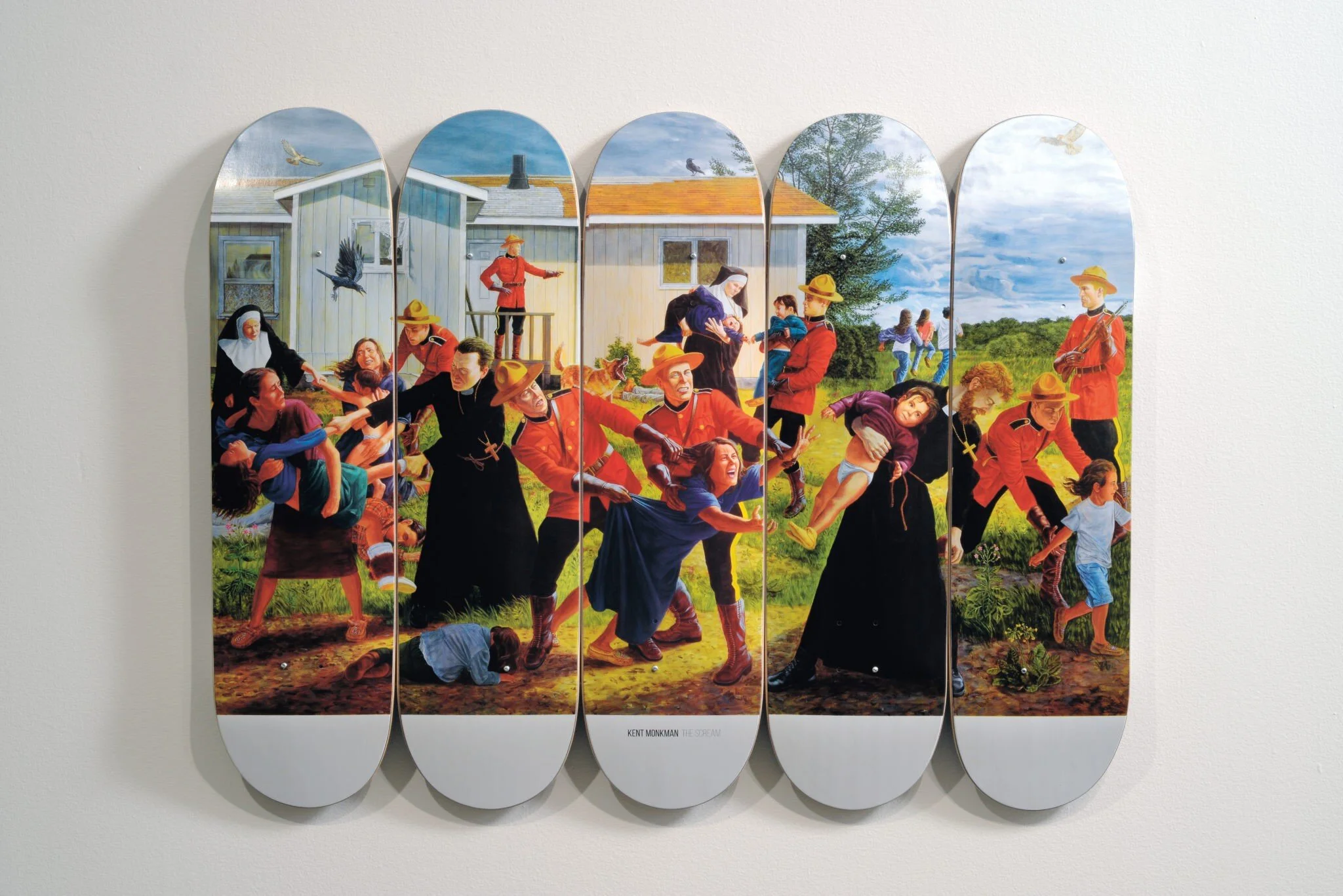Boarder X carves out Indigenous identity through snowboarding, surfing, and skateboarding
The interdisciplinary exhibition now showing at Sk̲wx̲wú7mesh and L̓il̓wat7úl Cultural Centre merges art, sport, and culture
Colonialism skateboards by Michael Langan with Kent Monkman, Salteaux, Cote First Nation, is among the pieces that make up Boarder X.
Boarder X runs at Sk̲wx̲wú7mesh and L̓il̓wat7úl Cultural Centre to October.
SURFING, SKATEBOARDING, AND SNOWBOARDING are more than thrilling sports in the hands, eyes, and minds of the Indigenous artists from across Canada featured in Boarder X. Rather, they’re a means to express a relationship to the land.
Winnipeg-based interdisciplinary artist Jaimie Isaac, a member of Sagkeeng in Treaty 1 territory who has a Master’s of Arts from the University of British Columbia, curated Boarder X, which launched in 2016 at the Winnipeg Art Gallery. Isaac, an avid snowboarder, surfer, and mountain biker, is the gallery’s curator of Indigenous and contemporary art.
Consisting of painting, mixed media, carving, sculpture, weaving, photography, video, and performance, the exhibition now running at the Sk̲wx̲wú7mesh and L̓il̓wat7úl Cultural Centre (SLCC) in Whistler explores space, place, and belonging.
“Reading the urban terrain, making a cement jungle a playground, riding the natural contours of the white immovable mountains or shredding the ever-changing waves: these are responses to the land,” the exhibition’s program notes. “It is not about controlling land and water, but being humbled by their power….It [the exhibition] is an affirmation and transmission of cultural resilience and acknowledgement of ongoing respect and reverence for the land.”
Snowboard photography by Mason Mashon, Saddle Lake Cree.
SLCC curator Alison Pascal says that, as people of the land, Squamish Nation and Lil’wat Nation members interact with their territories beyond traditional methods, including by engaging in modern sport. Local organizations such as Indigenous Lifesport Academy (formerly the First Nations Snowboard Team) and Indigenous Women Outdoors highlight the popularity of outdoor recreation among Indigenous people; Pascal describes the exhibition as a confluence between sport and culture.
“We have a lot of Ambassadors who participated on the First Nations Snowboard Team (now Indigenous Life Sport Academy), and skateboard,” Pascal said in a release. “Indigenous people are athletic in nature; we are excited to feature this exhibit that looks at and acknowledges that truth.”
Among the participating artists are Mark Igloliorte, an Inuk artist living in Vancouver whose painting and drawing has been exhibited in group and solo shows across Canada; Vancouver-based Métis artist Les Ramsay, who studied visual arts at Emily Carr University of Art and Design and at the Universitat de Politecnica in Valencia and who completed his MFA in painting and drawing at Concordia University; and Roger Crait, a Status Indian from Winnipeg who studied Fine Arts at the University of Manitoba, who worked with a group of 10 artists in Cranberry Portage on a sculpture for the 2010 Olympics.
Steven Thomas Davies is a filmmaker of Coast Salish (Snuneymuwx) and European descent based on Vancouver Island whose works include Ahousat going? A Portrait of the Ahousaht, a documentary that followed the West Coast community’s response to a suicide crisis in 2004.
Pro mountain biker Mason Mashon grew up in Vernon and spent a great deal of time living in Whistler, where he became one of the area’s most prolific ski, snowboard and mountain bike photographers and has hosted Crankworx Whistler, the largest mountain bike festival in the world. He also hosted his own action sports TV show, UnderExposed, which followed his life as a freelance action-sports photographer and aired in Canada and the U.S.
Snowboarder Meghann O’Brien is a Northwest Coast textile artist working in the traditions of basketry, Yeil Koowu (Raven’s Tail) weaving, and Naaxiin (Chilkat) weaving. The descendent of the Kwakwaka’wakw village of Weka’yi T’sakwa’lutan (Cape Mudge); the village of Kiusta, Haida Gwaii; and Dublin, Ireland did a strict traditional apprenticeship under master Chilkat weaver William White.
Jordan Bennett is a Mi’kmaq multi-disciplinary visual artist from Stephenville Crossing, Ktaqmkuk (Newfoundland), who has shown in venues such as New York’s Museum of Art and Design, Museum of Contemporary Native Arts in Santa Fe, Musée d’art contemporain de Montréal, Paris’s Institut du Monde Arabe, and the Vancouver Art Gallery, among other places. Bennett has also represented Newfoundland and Labrador at the Venice Biennial at Galleria Ca’Rezzonico.
For more information, see SLCC.













